
Listen to the entire first hour of this 3 part series here.
The Immigrant Experience (3 one hour episodes) focuses on the most intensive period of immigration in American history — from 1890 to 1922 – when some 20 million immigrants primarily from Russia, Eastern Europe and Italy poured into New York’s harbor and Ellis Island and ultimately the streets of New York.
This series — produced by Gail Pellett, Beth Friend and Nina Mendes for WBAI, New York in 1975 — features poignant interviews with surviving immigrants from that period by the producers along with interviews from a social history collection at the City University of New York. The programs integrate period music, dramatic readings from diaries and memoirs, documents and newspaper reports along with extensive comments by Professor Elizabeth Ewen, who teaches American History at State University of New York at Old Westbury and writes about that critical period of American immigration.
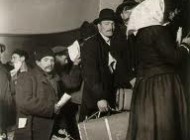
Part 1 – Journey to America
This first hour features poignant interviews with immigrants who made the journey from Russia, Eastern Europe and Italy as well as other parts of Europe reveal that people were fleeing persecution in the form of pogroms, poverty, conscription in the Czar’s army and the restraints of autocratic life. At the same time the industrial machine of the U.S. needed labor and that message reached into the villages and cities of Europe to entice potential immigrants. Steamship companies sent out agents to sell tickets on their boats. Families and communities would save, borrow, lend to send one of their members to America.
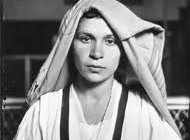
“Those people came here without nothing. They sell everything, borrow, they think everything was going to be better in America.”
The interviewees describe the horrible conditions of steerage on the two week boat trip from ports like Bremen. Women were molested by the crew, sanitation was minimal, food was rotten and everyone was seasick. But that was only the beginning. When they arrived in Ellis Island chaos prevailed. They couldn’t understand the language, they were quarantined if they were sick, they had to prove they could work and that they could support themselves, then their names were changed to make them easy to pronounce. Giovanni was now Joe.
What these immigrants found when they arrived was both better and worse than they imagined. Their fantasies and dreams of freedom, democracy and gold were now challenged by reality.
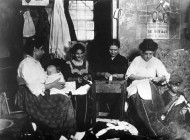
Part 2 – Making a Life
When the new immigrants arrived they were faced with staggering challenges of language, culture and the battle to survive. Called “Greenhorns” they immediately spent their first money on American clothes so they wouldn’t look like hicks from the old world. Then they had to find work. This episode features women immigrants on the Lower East Side of New York City who primarily worked in the garment trade. Young women labored in crowded sweatshops at machines. Bound to cramped tenements, mothers and children took in piece work. The whole family worked just to pay the rent and eat. “We worked long hours for low pay.”
“I spent 5cents a day on my food — a bread roll, an apple and tea. Everybody shared with their friends and family. Some sent money back home to Europe.”
An Hungarian woman tells how she used to sing the whole day at her machine. Her co-workers and boss thought she was singing from happiness, but “I was singing to forget.”
A Czechoslovakian interviewee describes working as a maid to wealthy uptown folks. “I was only 14 and I was sold for $5 just like that. I had to run all the time to keep up with everything. I needed skates. They had seven rooms! I was so lonely. But then one day I went out with the baby and heard other maids in the street who spoke my language. I yelled Yoohoo! I’m Czech, too!”

Many sweatshops lacked ventilation or sanitary conditions. “Each and everyone of them had TB. Everybody was always coughing.”
Despite the long hours of work and the cramped spaces for living, there was another life. These interviewees describe Yiddish theater on the Lower East Side, concerts in Central Park, debates, talks and movies.
“Everyone had different dreams and ambitions. Some were terribly unhappy, others pursued education and activities to make their lives rich.”
Part 3 – Organizing for Change
Many of the immigrants at the end of the 19th and early 20th centuries were fleeing political persecution in Russia or Eastern Europe or at least the heavy hand of autocratic governnments. Many had socialist leanings. They believed that America represented their socialist dreams — with its freedoms and democracy. When they arrived they often sent money back home for political journals and realizing the conditions for workers here, they got involved in union organizing.

One interviewee describes the Triangle Shirtwaist Fire of 1911. She had just quit working there the day before because she refused to work overtime. When the fire started the girls were locked in and there were no fire escapes. More than 140 women were killed. That event spurred the union movement in New York and throughout the Eastern U.S. One of their first goals was to pass child labor laws.
Sweet Maria of the Tenements
Professor Elizabeth Ewen describes “Sweet Maria of the Tenements,” an anarchist who watched the horrible conditions of workers and residents on the Lower East Side and one day took a gun and marched into John D. Rockefeller’s office uptown. Fortunately, he wasn’t there. So she went back downtown and saw the women overturning pushcarts because of the high price of food, then she met with Trotsky, who was visiting New York, to discuss the revolution in Russia. Sweet Maria was the “go to” person for all complaints against landlords, bosses and peddlars trying to gouge the community.
Others describe going to debates and lectures with “radical” participants. Dr. Lieber lectured young people about sexual relationships. Emma Goldman spoke out about birth control. Another describes 150,000 demonstrators in Union Square for May Day in 1914 or 15. They may have worked long hours, but some managed to educate themselves and become leaders in their community and beyond.

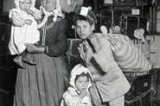


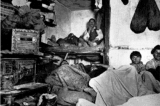
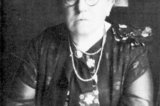
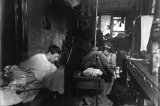
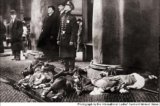
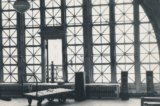
Oh how I miss radio documentaries! It’s such a rich form, the images explode, in a way more vividly than on TV or even in the movie theater. And this subject is perfect for the form. You did a fabulous job mixing sound backgrounds with interviews with narration! I love it!!